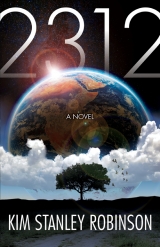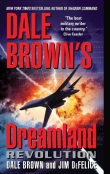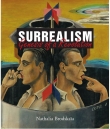
Текст книги "2312"
Автор книги: Kim Stanley Robinson
Соавторы: Kim Stanley Robinson
Жанр:
Научная фантастика
сообщить о нарушении
Текущая страница: 16 (всего у книги 36 страниц)
Lists (7)
inadvertent fracking—failed seal—bad lock—bad luck—hyperbaric spark fire—carbon monoxide buildup—carbon dioxide buildup—design flaw—engine housing crack—sudden air loss—solar flare—fuel impurity—metal fatigue—mental fatigue—lightning strike—meteorite strike—accidental critical mass—brake failure—dropped tool—tripped and fell—coolant loss—manufacturing flaw—programming error—human error—containment failure—battery fire—distraction—AI malfeasance—sabotage—bad decision—crossed wires—recreational mental impairment—cosmic ray impact—
(from The Journal of Space Accidentsvol. 297, 2308)
Extracts (8)
Charlotte Shortback’s periodizing system was very influential. Of course, the idea of periodization itself is controversial and even suspect, as it seems often to be a matter of squinting hard and waving one’s hands in belletristic fashion to make sock puppet myths out of the dense “buzzing and blooming confusion” of the documented past. Nevertheless, there do seem to be differences in human life between, for instance, the Middle Ages and the Renaissance, or the Enlightenment and the Postmodern; and whether these differences were caused by changes in modes of production, structures of feeling, scientific paradigms, dynastic succession, technological progress, or cultural metamorphosis, it almost doesn’t matter. The shapes invoked make a pattern, they tell a story that people can follow.
Thus for a long time there was a widely agreed-upon periodization schema that included the feudal period and the Renaissance, followed by the Early Modern (seventeenth and eighteenth centuries), the Modern (nineteen and twentieth), and the Postmodern (twentieth and twenty-first)—after which a new name was most definitely needed. For a long time this need generated competing new systems, and that competition, along with the generally microfine narratology of the historians of the time, combined to foil the invention of any new system that was as universally agreed-upon as the old one had been. It was only in the last years of the twenty-third century that Charlotte Shortback offered to the historical community her own periodization scheme, for what was by now the “long postmodern” so endlessly bemoaned at conferences. Hers was partly a joke, she later claimed, but it has become influential since then despite that, or even perhaps because of it.
For Shortback, the long postmodern was to be divided like this:
The Dithering: 2005 to 2060. From the end of the postmodern (Charlotte’s date derived from the UN announcement of climate change) to the fall into crisis. These were wasted years.
The Crisis: 2060 to 2130. Disappearance of Arctic summer ice, irreversible permafrost melt and methane release, and unavoidable commitment to major sea rise. In these years all the bad trends converged in “perfect storm” fashion, leading to a rise in average global temperature of five K, and sea level rise of five meters—and as a result, in the 2120s, food shortages, mass riots, catastrophic death on all continents, and an immense spike in the extinction rate of other species. Early lunar bases, scientific stations on Mars.
The Turnaround: 2130 to 2160. Verteswandel(Shortback’s famous “mutation of values”), followed by revolutions; strong AI; self-replicating factories; terraforming of Mars begun; fusion power; strong synthetic biology; climate modification efforts, including the disastrous Little Ice Age of 2142–54; space elevators on Earth and Mars; fast space propulsion; the space diaspora begun; the Mondragon Accord signed. And thus:
The Accelerando: 2160 to 2220. Full application of all the new technological powers, including human longevity increases; terraforming of Mars and subsequent Martian revolution; full diaspora into solar system; hollowing of the terraria; start of the terraforming of Venus; the construction of Terminator; and Mars joining the Mondragon Accord.
The Ritard: 2220 to 2270. Reasons for the slowing of the Accelerando are debated, but historians have pointed to the completion of Mars’s terraforming, its withdrawal from the Mondragon and increasing isolationism, the occupation of all the best terrarium candidates, and the nearly total human entrainment of the solar system’s easily available helium, nitrogen, rare earths, fossil fuels, and photosynthesis. It was also becoming clear that the longevity project was encountering problems, and was not completely distributed in any case. Recently some historians have pointed out that this was also the time when quantum computers reached thirty qubits and were combined with petaflop classical computers to make qubes—their point being that qubes have not yet been demonstrated to improve the function of already fast AIs, while the decoherence problems inherent in quantum computing may have helped create conditions for the next period:
The Balkanization: 2270 to 2320. Mars-Earth tension, aggression, and cold war for control of the solar system; Mars isolationism; Venus internal strife; decision in the Jovian moons to terraform their big three; proliferation of the unaffiliated terraria, and the disappearance of many populations behind “event horizons”; influence of qubes; volatile shortages pinching harder, causing hoarding, then tribalism; tragedy of the commons redux; splintering into widespread “self-sufficient” enclave city-states.
The term “hyperbalkanization” Shortback considers just an artifact of overheated rhetoric in cultural studies.
She has said, however, that a significant prolongation of the Balkanization could perhaps lead to a period worse than the Ritard, or even the Crisis—perhaps a time that could be called the Atomization, or the Dissolution.
She tells a story about how once in a talk she suggested that the entirety of the last millennium could be called the late feudal period, and afterward a man came up to her and said, “What makes you think it’s late?”
But what happened in 2312 suggests that the twenty-fourth century will mark a turn
IAPETUS
Iapetus looks like a walnut, because it is squashed at the poles, and has a prominent equatorial bulge, both quite visible from space. Why is it squashed at the poles? At one point it was melted and became a big water drop rotating rapidly, its days only seventeen hours long; something passing by set it spinning like a top. It froze while still spinning. So, why the prominent equatorial bulge? No one knows. Some aspect of the freezing of water drop to ice ball, most agree, some kind of surge or excess. But it’s something saturnologists still argue about.
Whatever caused it, the bulge immediately suggested itself as an obvious location for a city, as it could serve as something like a High Street peninsula running all the way around the moon. The city was concentrated at first on the hemisphere facing Saturn, which looms overhead four times larger than Luna from Earth. This was felt worth having in one’s sky, especially since Iapetus’s orbit is at a seventeen-degree tilt from the plane of Saturn’s rings, giving it a perpetually changing view of the gorgeous mobile. Almost all the other moons see the rings only edge-on. From the Iapetus bulge one also has a view down to the rest of the moon’s surface, twelve or sixteen kilometers lower than the bulge, so there is always a broad icescape below to balance the sublime ringed pearl above.
What color the moon’s surface is depends on where you are looking, because the leading hemisphere of Iapetus is quite black, while the trailing hemisphere is extremely white. This stark discrepancy, noted by Cassini in October of 1671 when he discovered Iapetus, is a result of the moon being tidally locked. The same hemisphere always leads the charge into the night, and black dust shed by the retrograde moon Phoebe (the other one out of the plane of the rings) therefore always falls on that side. In four billion years the dust has accumulated to a depth of only a few centimeters. Meanwhile the trailing hemisphere of the moon, gathering frost from the ice subliming off the darker leading side, is among the whitest ice in the whole system. The result is a two-toned moon, the only one in the solar system.
When people came to occupy Iapetus, the top of the equatorial band was smoothed and fitted with a rock-and-aluminum foundation. They then began to use seashell genes to shape the structures of the equatorial city. Some of the flat top of the bulge has been left open for spaceport runways and the like, but most of the bulge is now covered by a long clear gallery tent, placed over buildings that line the great boulevard of the High Street, alternating with farms, parks, gardens, and forests. As the air under the tent is always kept warm, the interior architecture can be very open, with Saturn often left visible, framed by gaps in ceilings and roofs. Seashell biomimicry allowed the builders to extract and deploy calcium under mantles, and these soft living tissues were genetically engineered to shapes that allowed the architects to layer bioceramic stuctures one on the next, building structure on structure, like corals, until the area under the tent by now is almost full. Like most bioceramics structures, the beveled and layered shapes have been induced to produce scalloping, fanning, notching, and other conchological features, so that the buildings look like great seashells stacked one on the next. Sydney is often referenced because of its iconic opera house, but in fact the bulge now looks more like a Great Barrier Reef made of scallops layered and everywhere holed, as if by tube worms, to let in the view of Saturn overhead.
On the black hemisphere, Cassini Regio, the bulge bisects an area where people once upon a time went out in hoppers or rovers and blew the black dust away to make patterns out of exposed white ice. Anytime you can easily make such a contrast in the landscape, people have written out their thoughts for the universe to read. Before the Saturn League was formed, when the first arrivals from Mars had come for Titan’s nitrogen, and were exploring the other moons as well for whatever else might be plundered and taken back to the red planet, people had come here and etched white out of the black. An exhalation no stronger than a leaf blower’s would do the job, and soon great fields of Cassini Regio were covered like Newspaper Rock with petroglyphs. There were white-on-black figures in abstract patterns, beasts, stick people, Kokopellis, writing in many different alphabets, portraits, landscape features, trees and other plants; on and on it went. Later some entire areas were cleared completely to white and then painted with collected black dust to a greater or lesser depth, achieving shadings that had a sometimes trompe l’oeil depth of field, proportioned for viewing such that they looked normal when viewed from the bulge, with others designed to be viewed from space.
Graffiti on Iapetus! Later it was declared a mistake and a scandal, a moral stupidity, even a crime, in any case disgusting; and there were calls for the entirety of Cassini Regio to be reblacked. Someday it may happen, but don’t hold your breath, for the truth is we are here to inscribe ourselves on the universe, and it is not inappropriate to remind ourselves of this when blank slates are given us. All landscape art reminds us: we live in a tabula rasa, and must write on it. It is our world, and its beauty is entirely inside our heads. Even today people will sometimes go out over the horizon and scuff their initials in the dust.
WAHRAM AT HOME
Wahram returned to Saturn a haunted androgyn. Despite all his theories, he was still in the tunnel. He tried to get back into the pseudoiterative of his life on Iapetus, and indeed in some ways it was easy; it wasn’t a life he was ever going to forget. For a day or two it was possible to feel odd to be in a city you hadn’t been in for years and yet magically wake up knowing right where to go, the little grocery around the corner where you could get fresh bread and milk and all that; then the intervening years sloughed away and it was just home again. Off for the walk to work, down the long esplanade by the north window wall, overlooking the immense drop down the slope of the bulge. Black-tipped whites at the border of the Cassini region: a vast Chinese landscape painting, black brush tips on white paper. At the notch of one little small square, the council offices were up in a squat clear-walled tower, offices with lots of people he knew; it was like dropping back into an earlier reincarnation. He could reenact it meticulously; he could perform it like an actor in a play set in the previous century; he could make it a daily devotional, live ordinary life as a déjà vu that he invoked himself—but no.
No. Because the much more strict pseudoiterative of the tunnel still filled his mind, and overlaid the sensations of the present moment. And as Iapetus in the present was for the most part an Iapetus reenacted, much more vivid to him was that more recent past consisting of what he had just lived through with his so-mercurial friend. And he wondered about her. The mercurialities of Swan were infinite, but she had gone through quite a bit down there, and so had he. She had protected him at the elevator door, just as a matter of course, the obvious thing to do, with no time to think; just an animal response. And with far too much time to think, he had helped her through her radiation sickness.
So when he thought he wasn’t thinking of anything, he found himself whistling snatches of Beethoven, and hearing over it a skylark filigree of inhuman virtuosity. He wondered what they had really sounded like, and if Pauline had recorded the entire time and could carve out and play back the music they had made—another kind of transcription. All those poor musicians… Maybe a record was always a distorter of memory, not to be sought. Better to hear it by way of reenactment. He would only really hear it again if they did it again.
No. He needed to think about something else, and bring himself into the present. Possibly he would see Swan again somewhere, and they would whistle then, or not. Probably not, this being the world. So… recent or not, the past was the past; the present was the only reality. So really, it was necessary to start up a new pseudoiterative that did not rely so fully on his habits from three or four lives back. He needed a new Iapetus, with the memory of Swan properly encoded into it.
So he would walk down High Street to the park with the best view of Saturn for an evening constitutional, for a communing with the great ringed god, and perhaps a chance to see Titan-his-true-home spangling over the giant like a jewel; and just the act of trudging to the park would bring a whole host of feelings to him; and in the park a small gathering of musicians would pass around the chance to start up a tune and have everyone join in, and he could either listen, or venture to whistle along—even to whistle the start of some movement when it was his turn—end of the Sixth, end of the Seventh—and they all would join in on their instruments and off they would go. With Saturn overhead, and some truly gifted musicians in the little band, he would be snagged by the moment, fully entangled, and Swan would be there with him in his mind. What a temper she had.
Then on days when the council and various work groups weren’t meeting, he could tram around the city four degrees, and come to the gate for the ski boats, and get in one and take off down the gigantic side of the Iapetus bulge, in this region an undulant slope of black-tipped white billows, in some parts like a shaken sheet of snow, in others like frozen waves in a waterslide. There were moguls the size of big hills. Down the great hill of the bulge’s side the ski boats would slide, carving lines and performing jumps and rollers, if desired; but also one could simply cut a line and keep to it on a long traverse, or even fly straight down the slope, a forty-five-degree drop, and even at the highest speed the descent took all day. Rides went on so long that many people slid down on larger boats to have a party, and on some days Wahram tried that too. Then at the bottom they got into funiculars for a ride back up, during which everyone was in high spirits, often expressed in song. People shared schnapps and sang Schubert. Wahram had done these things long before, in the first year he had lived in Iapetus, but somehow they had dropped out of his habits and been forgotten. Now thinking of Swan had brought them back into his life.
Even his work brought Swan to mind, as the council and its staff were discussing what to do about the light deal with the Vulcanoids now that Terminator had been destroyed. Wahram pointed out to his colleagues that Terminator would be quickly rebuilt and repopulated, and thus remain a treaty partner with whom they already had an agreement. Alex’s death did not change that agreement. He could see that while this was obviously the case, stating it aloud only tagged him among his colleagues as biased, which was true, so after that he went silent and only listened to what the others said about it, which really was nothing surprising: many of them had not liked the arrangement with Mercury in the first place, and now they reverted to these views and argued that they should be making their deals with some kind of Vulcanoid league, or even with individual Vulcanoids. These were not, after all, spaceships, but small asteroids located in the gravitationally stable orbit between .06 and .21 astronomical units from the sun—thirty-kilometer rocks, white-hot on their sunward surfaces, and just big enough to spin out their solettas and contain in their interiors the little habitats that their operators or votaries lived in. These were city-states just like any other city-states, some of Wahram’s colleagues insisted, and should not be represented by some exterior power like Terminator, no matter what Alex had asserted. How would the city-states of the Saturn League like it if some Jovian party claimed to represent them just because it orbited between Saturn and the rest of civilization? Wasn’t that ultimately the argument that Terminator had been making in this case? Wasn’t this in fact yet another move in what some had called the Alexandrine Integration, the offline effort to bypass the AIs and unify the entire system—under Alex?
Not exactly, others had replied, to Wahram’s relief, as he had been working with Alex on precisely this project, which was not exactly as characterized by these colleagues but would be difficult to explain in the context of that accusation. Much better to observe silently and let the argument drag on in the long and leisurely way typical of the council, until it had moved on its own to something else. The councilors from Hyperion and Tethys were the main reasons this would take a while; they were both very long-winded, also maniacally focused on the minutiae of matters they took an interest in. The council was one of the many organizations in the Saturn League made up of drafted temporary workers, and the permanent staff there to assist them often had to Sir Humphrey the process along, guiding their employers invisibly through every decision. But some of the ministers, having been selected by lottery and assigned a year’s responsibility for the Saturn system’s welfare, intended to be in full command of their own decisions, and to make the best decisions they could by being fully informed. Admirable in theory, it was painfully slow in practice.
So in this discussion the dispute kept on seesawing between the idea that Mercury was the legitimate, or in any case agreed-upon, broker in the matter, and furthermore could make things difficult—and besides had things to offer Saturn—and the idea that the Mercurials were interlopers who had succeeded in imposing a protection racket on the new little settlements inside it, and so should be finessed out of the deal in this their winter of discontent.
Ultimately the council came to a conclusion Wahram had foreseen hours before: as Wahram himself was so sympathetic to the Mercurials, he was to return there and see what the situation was, talk to the lion cubs and find out who the next Lion would be, and then also go visit the Vulcanoids and see what they had to say for themselves—see what they thought of the arrangement Mercury had proposed to Saturn. He was instructed to revise Terminator out of the deal if he thought that would work.
Probably he should have refused to do it based on his dislike for that last instruction, but it occurred to him that a different delegate might mean an even worse result for the Mercurials. And after all, the assignment meant he would very soon return sunward, which was interesting to contemplate. As for his instructions, he could see about that when he got there. In Alex’s realm in particular, an ambassador was again as of old, a diplomat at large, charged with making decisions as well as conveying them. By the time he got there it could very well be a different story. With a little forethought, he could be almost sure it would be a different story.
So he said nothing beyond a simple acceptance of the assignment.
At which point the Satyr of Pan stood to speak. “You must tell us if you think this effort will make trouble for the other projects Alex had going. Can you remind the council what’s at stake here, and how those projects are going in her absence?”
Wahram nodded stiffly as he thought over his response. He and the other Alexandrines were attempting to keep a low profile, and some of the council members had not paid enough attention to notice their projects’ authorization and budgeting inside larger expenditures. “Alex kept things separate in her calculations, so that won’t be a problem for us. Some other matters are being dealt with by a group centered around Wang and Inspector Jean Genette. We would need to go under a cone of silence to discuss all this in detail, but suffice it to say, Alex was heavily involved with a Mondragon project to help Earth cope with its various problems by ecological means. A lot of the terraria in the Mondragon are working on that, it has its own momentum, and we’ve agreed to help them. Then also there is an investigation going on into the role of qubes in some questionable activities, on Mars, Venus, Io, and elsewhere. This also will proceed no matter what happens with the Vulcanoids, which is only an above and beyond, although admittedly an important one.”
The council, not wanting to retire into the cone and be cut off from the cloud and radio, adjourned the meeting. Wahram returned to his room. His crèche kept an apartment in a little block of apartments, all clustered around a square that was occupied almost entirely by Titans, with Titanic shops and restaurants. There he lived among his crèchemates and enjoyed their support, which was so benign and understanding that life there much resembled living in complete solitude. As the days passed before the spaceliner that would take him downsystem arrived, he walked the city spine to the council meetings, he followed the work on Titan in daily consultations, and he did his share of Iapetus work in the kitchen of the dining hall on the ground floor of their building. He attended a concert series, joined the little group of musicians in the park, filled and emptied dishwashers. As he dodged diners and servers in the hall, the repeated minuscule navigational challenges reminded him of Proust’s comparison of a restaurant in action with the whirling planets of the solar system, which had struck him as fanciful (not to mention quite a scale shift between vehicle and tenor) until he had seen it for himself, in restaurant after restaurant: their affairs were elaborations of the second law of thermodynamics, Beckian diffusions of energy through the universe, and around they went in the great orrery of their lives. Soon he would descend sunward and seek out the Mercurial.
But then she called him. She was coming to Saturn, with Jean Genette; they wanted to descend into the clouds of Saturn to look for a spaceship possibly adrift in the big beauty’s upper layers. She wanted him to arrange the dive into Saturn, if possible, and then join them in it.
“That would be fine,” he replied; “I am at your disposal.” Which was certainly one way of putting it.








